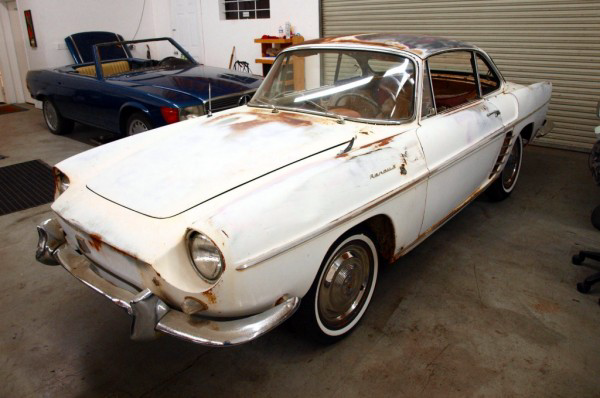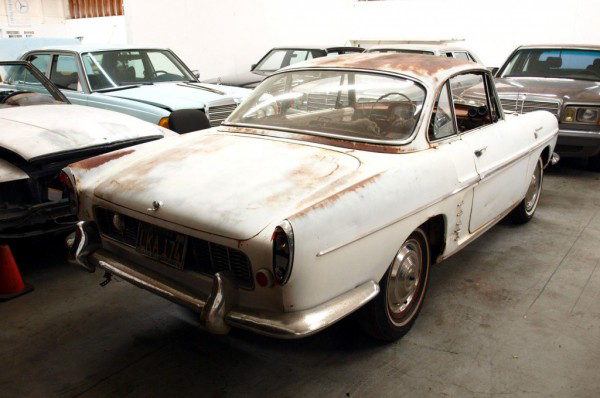This certainly is an unusual one! Caravelles were produced for 10 years, and although over 100,000 were produced the survival rate is very low, especially on this side of the Atlantic. This one is currently in what looks like a Mercedes specialist in Auburn, California, and is up for sale here on eBay with a buy-it-now of $3,500.
Although the car is not currently running and is said to have been off the road since the 1970’s, it appears relatively solid and comes with an extra engine and transmission. There’s no obvious accident damage, but unfortunately pictures do not include closeups of the interior. What you can see of the seats looks like there’s not much left to work with. All four wheel covers are present, though, and the trim all seems to be there as well. I wish sellers like this would take the time to show the underside of a car (it’s a shop, you can bet they have a lift) and would see if the engine were frozen or not. I guess I shouldn’t complain at this price—what do you think?




Looks solid. Not a bad price either. Maybe a good candidate for an updated (and reliable) powertrain???
Sooo, that must be a steel hardtop? From personal experience (not mine, a friend in late 70’s) These cars will literally break in half if there is any rot. If you get into it, leave the roof on, strip the interior and add bracing fore to aft inside or underneath. My friend basically had both door open, two people sat down and bam. Their butts were on the ground.
I had two Renault 4CV’s during the same period. Talk about funky. Suicide doors in the rear and you could insert a crank through the rear bumper to start it. Best done when its already warmed up.
Hi Stuart, I had a similar experience with one of these. My old man bought and sold cars as a sideline when I was a kid (60’s) Renault’s (he called them “Renultz”) were the only foreign car he’d buy. He had a few Dauphine’s, but took in a Caravelle once. It too sagged in the middle and he had to have it braced before he could sell it. I had a 4CV too as my 1st car. I always wondered how many people put gas in the radiator, as the gas filler was next to the heater box under the hood.
A lot of these cars came to the US. Years ago these were almost always available,for cheap. I never took them too seriously.Most have been scrapped,I guess
Sadly, this year Caravelle has the least desireable attributes of the entire production run – powertrain is carryover from the 4CV and early Dauphine, meaning the radiator is between the gastank & the engine, and waterpump is there also – very hard to get to, fanbelt is up there too – lousy location! Lowest hp engine, probably around 850 cc, weakest chassis – basically a Dauphine with the roof lopped off – unibody sills very weak, cars fold in half when doors open, can already see rotthru at front of one sill below doorhinge pillar. Having owned two ’67s which had the slightly strengthened sills, and far better radiator at engine rear along with waterpump and fanbelt, plus 1100 cc engine and nicest dash, I suggest running away from anything earllier than ’65 when the sill “fix” was in. Also, I think the 4 wheel disc brakes came in only in ’63 or later – same as R8/10 sedans. Lawn ornament only!
PS: I let my two ’67s go for only $1500 each, both ran & actually had decent interiors, but Michigan one was ready to fold. Cal. one was solid, with new waterpump and work I had done. Sure wish I had been able to pull what they’re asking for this one –
With the seller actually admitting there is body rust to be repaired, I wouldn’t bite until I either knew or saw how much rust there was and if the structure was compromised. Considering the seller does NOT have any pics underneath and then sticks those vintage pics on, I’m sure he’s expecting someone to get excited and pull the trigger ’cause it looks like a fun, oddball car…
Good cars and not that rare. I have driven many Renaults and the engines are super reliable and remarkably powerful! The big problem with them in the USA was that the cooling system needed to be bled if drained or overheated and people were not used to that here. This lead to the bad reputation from overheating due to air in the cooling system and only a faint idiot light.
The best memory I have of a Caravelle (called the Floride in the home country I believe) was at a time trial that was held on a giant parking lot in the Northeast in very early Spring. It had snowed, then melted a bit. The course was a slushy unplowed mess.
The fastest time was set by a good driver in a Caravelle. Everyone else had more powerful front engine / RWD sportscars like MGAs, TRs, and small sedans that couldn’t match his time. I don’t think there were any 356s there that day or they would have beat it. Everything else I saw connected with Caravelles was downhill from there, unfortunately.
They just weren’t suited for life in No America, so after a couple of years of seeing a few of them in the Northeast, where imports sold fairly well, you pretty much never saw these again. No surprise this one was used only 10 years in California.
I never saw these as a kid. There were a lot of euro models imported in the 60s I was unaware of, and we lived in a college town, so I’m not sure how they escaped my notice. Maybe we were just from the wrong side of the tracks…
I owned and raced a number of Renaults in the late ’60s/mid-’70s (4-CV, Dauphines, R-8, R-10, R-17 Gordini) and love them. They handle much better than the VWs and many so-called ‘sports cars’ of the time. I never owned a Caravelle and would love to restore (and ‘modify’) one some day (when I have the time).
The only problem Renault had when they came to the USA in the late 1950s (before VW) was they didn;t have enough repair facilities.
Hey Al,
The “other” problem was their push button transmission. Had to finally get rid of my ’65 Dauphine. Can you imagine; sold it for $75, and everything about it was cherry but for the tranny. Oh well…
Where’d you race?
I never knew you had these in the USA! The early model was a Floride but it morphed into the Caravelle. You would really have to know these to understand the differences!! In Europe it was a car driven by glamorous women. The streets of Paris were littered with them.London too. Caravelles seemed to start life in the European cities. Then the rust started, they disappeared as a consequence, becoming rare. You can find ones without rust in Southern Europe. As they are R8 based, tuning one is easy and very effective, possibly the ultimate period conversion was a tuned R16 TS engine, that became a seriously quick car. Fitting an R21 turbo drivetrain might be todays ultimate sleeper, if it will all fit, especially with 4 wheel drive from the later models. Scruffy but running R21 turbos can be had for peanuts for the moment. Bear in mind R21 turbo was considered a serious Ford Sierra Cosworth rival. This Caravelle looks just about restorable at a cost. But a money pit and not worth that much at the end, so IMO it is a scrapper. You can buy nice ones and they would be cheaper in the long run, either left as is or turned into a wicked sleeper.
In looking at pictures of finished ones, it reminds me a bit of a Volvo P1800 having a one-night stand with an Amphicar. Not my speed, but rarity always makes for an interesting story.